About
Ariaú Towers
Sub-Menu
Related Links
|
Virtual Tour of Ariaú
Here is a description of my stay at Ariaú in January
1997. My stay lasted for three days, and was recommended
to me by my Brazilian friend, Susi, who had read about
the lodge in a local magazine. The lodge is also
frequently mentioned in travel guides about Amazônia.
Even if you can't travel to Amazônia yourself,
hopefully the following photographs and story will give
you a small taste of what its like.
Day One: January 2
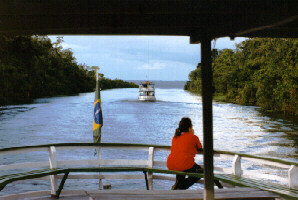 Flew from Porto Alegre to Manaus
(via São Paulo). This is a reminder of just how big
Brazil is – the combined flights took five hours in
a Boeing 747. Flew from Porto Alegre to Manaus
(via São Paulo). This is a reminder of just how big
Brazil is – the combined flights took five hours in
a Boeing 747.
On our arrival at Manaus airport, we're met by
Charles, a French guide from Ariaú. Charles loads our
bags into the van, and asks us to wait around for a few
more minutes because a flight from the United States is
also soon to arrive, bringing more visitors. Fifteen
minutes later, we're all in the air-conditioned van as it
pulls up alongside a jetty in front of Manaus' Hotel
Tropical. We climb aboard a riverboat (called a gaiola,
by the locals) and set out on the two hour ride to the
lodge. For an extra charge, Ariaú can also arrange
quicker and more dramatic helicopter and speedboat
transfers – but the slow riverboat ride is a good
opportunity for us to relax and meet the other visitors.
Here we meet Regina, a very friendly and talkative
visitor from São Paulo, who engages Susi and I in an
interesting conversation about live, love, and
spirituality. The riverboat also lets us appreciate how
big the Amazon and Río Negro rivers are – the
riverbanks are so far away that we feel as if we're on a
huge lake, not a river! I move to the front of the boat
and look downwards. The waters of the Río Negro are
frothing foamy brown as the bow of the riverboat cuts
through them on its way to the lodge.
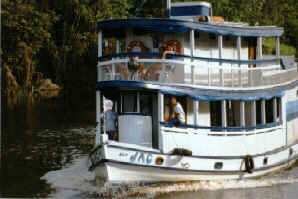 An hour and a half later, the
riverboat turns into a small channel where there are
trees overhanging the water on both sides. The scenery
changes – and although we can't see any wild
animals, we can see lots of exotic birds nesting in the
trees and flying overhead. An hour and a half later, the
riverboat turns into a small channel where there are
trees overhanging the water on both sides. The scenery
changes – and although we can't see any wild
animals, we can see lots of exotic birds nesting in the
trees and flying overhead.
Soon afterwards, we see a series of towers and other
structures rising through the canopy of the surrounding
rainforest, and minutes later the riverboat gently eases
into position alongside the small floating dock. Susi and
I grab our bags and climb down onto the dock. Some
middle-aged American tourists follow, but then stand
around waiting and demanding for a porter to carry their
huge bags up the stairs which lead to the lodge's
reception. Susi and I just look at each other, then put
on our huge backpacks and carry our own gear up the
stairs. The Americans are still waiting. Several of the
Ariaú monkeys are gathered nearby, curious to see who
the new visitors are.
We check in, and are shown to our room, and although
there are a few problems at first, Susi talks to Jilson,
one of the guides, and everything is soon straightened
out. Back in reception, Jilson officially welcomes
everyone to the lodge – including the Americans, who
are now there thanks to the efforts of several burly
porters. There are sighs of relief from all around when
Jilson adds that we don't have to worry about being
bitten by mosquitoes while at Ariaú. The acidity of the
surrounding river water (which is stained dark brown by
dissolved plant material, like a strongly-brewed cup of
tea) makes it an unsuitable area for mosquitoes to breed.
That night I sample lots of the local foods and juices
served in the dining room. Some of them I like, but
others will take getting used to. One of the Americans is
searching in vain for a burger and fries, though Susi
looks relieved that there aren't any around (I purposely
don't mention to her about my almost-daily lunch at
McDonalds).
After dinner I'm feeling very full – though learn
later that eating such a huge meal after several days
travelling wasn't a great idea. Eduard, our guide,
invites us to join an expedition looking for jacarés (alligators),
but I'm feeling tired as a result of the travelling and
the big meal that I've just eaten. Susi and I walk back
along the platforms to our room. It is dark now, and
there are some bats flying back and forth, dining on the
insects which have congregated around the outside lights.
Here, I discover that Susi, despite having been brought
up on a farm in rural Brazil, is very squeamish about
animals. On seeing the bats, she screams then runs down
the platform with her arms up over her head until she
reaches the inside of the next building. I just stand by
and watch in amazement, then follow much less
dramatically behind her.
Day Two: January 3
The next morning I'm feeling ill after having been
sick during the night – I feel as if I've been
kicked in the stomach by a mule. Susi and I get up and go
to breakfast, though it's a struggle for me to eat
anything. Regina brings me a cup of camomile tea and an
apple, saying that they will make me feel better. One of
the Americans goes back to her room and returns with a
mini-pharmacy, including pills for my upset stomach and a
sachet of Gatorade which she says will also help. I thank
everyone for their assistance, taking the pills, and
drinking the tea. It seems to work, because an hour later
I 'm feeling much better, though still not 100 percent.
In the meantime, I wander out and content myself by
feeding bananas, and other fruit taken from the dining
room, to the monkeys gathered around outside.
Soon afterwards, our group jumps into a motorised
canoe and travels off to visit a small river settlement
for an opportunity to see how the locals live. We
discover a small village where the houses are little more
than raised wooden shacks, with only one or two rooms.
Most of the group stays close to Eduard, our guide. But
Susi and I spot some kids nervously watching us from the
small porch of their shack, so we slowly wander up to
them, waving and smiling. We start chatting with them
(though the kids are laughing at my attempts at
Portuguese) – mostly we just exchange names, and ask
a few simple questions about their village. The kids
think that their village is much healthier than living in
a big city. I semi-successfully tell them that I am from
a place very far away, with Susi adding that I am from
New Zealand (Nova Zelandia) – but the kids have
never heard of it. One little girl is holding a small
puppy, so we talk about that instead. The kids are very
cute, and I am dying to take a photo – but I don't
wish to be too intrusive, so plan to ask them later.
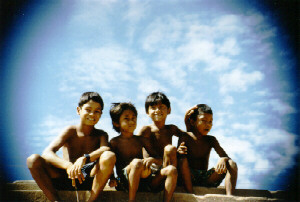 The
tour group moves on, so Susi and I walk back to join
them. They are getting a quick lesson about the crops and
other foods growing around the settlement. We then look
at some local crafts and buy softdrinks from the village
store. We stay for a few minutes, but then the tour group
starts to leave – so there's no chance of running
back to get the photo that I wanted. Fortunately, just as
we're leaving, I spot some more kids sitting on the steps
at the top of the jetty – we spend a minute waving
to each other, then I point to my camera and they reward
me with big cheesy smiles. I manage to snap a couple of
photos before our boat leaves. The
tour group moves on, so Susi and I walk back to join
them. They are getting a quick lesson about the crops and
other foods growing around the settlement. We then look
at some local crafts and buy softdrinks from the village
store. We stay for a few minutes, but then the tour group
starts to leave – so there's no chance of running
back to get the photo that I wanted. Fortunately, just as
we're leaving, I spot some more kids sitting on the steps
at the top of the jetty – we spend a minute waving
to each other, then I point to my camera and they reward
me with big cheesy smiles. I manage to snap a couple of
photos before our boat leaves.
On the way back, we stop at a small beach on the
river, and Eduard invites us to go swimming. At first I'm
a little nervous having heard about the piranha and other less
famous inhabitants of the rivers (even though the books
all told me that "incidents" are very rare)
– but no one else around me is concerned. About a
minute later, everyone else is already in the water, so I
opt to do the same. I'm also a little nervous about
showing off my little white NZ body (people on the beach
in Rio de Janeiro thought I was still wearing a
t-shirt!). The river water was warm, and if I tilt my
head backwards into the water I can hear the river
current pushing stones along the river bottom sounding
like the metallic clicking of free-wheeling bicycle
wheels. The swim is pleasant and relaxing – but
later (as we get closer to the lodge), Eduard tells us
the local legend of a huge anaconda snake
reportedly seen by fishermen several years before. The
fishermen fled in terror, but estimated that the snake
was about 25 metres long – twice as long as the
biggest anaconda ever recorded. Mind you, it isn't as if
fishermens' estimates have a great reputation for
reliability! Eduard also adds that the area around Ariaú
was used as a location for filming the recent Hollywood
movie, Anaconda.
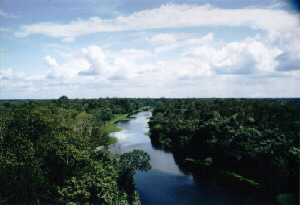 That afternoon after everyone
else has eaten lunch (and I've had another cup of
camomile tea), Susi convinces me to climb high up one of
the towers with her to take photographs. I reluctantly
follow behind her, not thinking that the climb will help
my delicate condition. The climb takes about five minutes
up the steep, narrow, and seemingly not very sturdy steps
which lead to the top of the tower. However, the view at
the top is worth it (even if my knuckles are turning
white as I grip tightly onto the railings). The land all
around us is flat – and there is rainforest
stretching out as far as we can see. That afternoon after everyone
else has eaten lunch (and I've had another cup of
camomile tea), Susi convinces me to climb high up one of
the towers with her to take photographs. I reluctantly
follow behind her, not thinking that the climb will help
my delicate condition. The climb takes about five minutes
up the steep, narrow, and seemingly not very sturdy steps
which lead to the top of the tower. However, the view at
the top is worth it (even if my knuckles are turning
white as I grip tightly onto the railings). The land all
around us is flat – and there is rainforest
stretching out as far as we can see.
The rest of my afternoon is spent resting and hoping
for my stomach to settle. As such, I opt not to join in
the piranha fishing with the rest of the group. Susi
tells me that she didn't catch any, though Regina caught
two small ones and kindly donated one of them to her.
Because piranhas have very sharp teeth, and can easily
bite through a normal hook, special extra-strong hooks
must be used when fishing for them. Piranhas are supposed
to taste delicious, but I never got to try any.
That night, feeling a little better, Susi and I
venture out on one of the guided expeditions to look for
jacarés. We head out down a small river tributary in
another motorised canoe armed solely with a spotlight. A
light rain starts about 10 minutes into our hunt, and
although Eduard gives us the option to turn back, our
group boldly resolves to continue – much to the
disgust of a old American couple included in the group.
Five minutes later, the drizzle turns into a torrential
downpour, and everyone is soaked in the first 30 seconds
– let alone the 15 minutes that it takes for us to
get back to Ariaú. Fortunately, most take the experience
with good humour knowing the risk that we'd taken with
our earlier decision. I manage to get a few
"interesting" surreal photos before my camera
packs in due to the moisture (fortunately it recovers the
next day).
The downpour continues as we arrive back at Ariaú,
where we rush inside to drink hot tea, laugh some more
about our experience, and then run back to our rooms to
get changed.
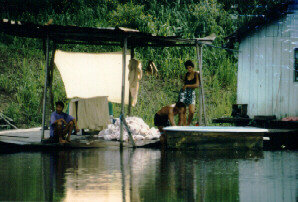 Day Three:
January 4 Day Three:
January 4
The next morning I feel much better than I did the
previous day. This is our last full day at Ariaú, and
after breakfast we set off on our first activity of the
day – a guided walk through the Amazon rainforest.
Although I've read many books about the rainforest, I'm
still unsure what to expect so I feel a little
apprehensive.
The area that we're going to walk through is located a
few minutes away by canoe. On the way out we pass
fishermen in canoes, and the hotel's "laundry
service" washing the lodge's linen in a tub using
water from the river.
Entering the rainforest is easier than I'd expected.
We follow an established trail so there's no need to
worry about slashing our way through dense undergrowth or
accidentally grabbing hold of a tree-living snake
mistaking it for an overhead vine. According to our guide
there are few chances of running into anything unpleasant
– because the trail is regularly used by humans,
rainforest animals tend to keep well away from it. We
trek on a circular path, with Eduard stopping regularly
to point out special rainforest plants and to tell us
about their uses. Some of the plants that we learn about
are a tree which produces a sweet creamy-white gum
originally used for bubble-gum, the ingredient used for
making Vicks VapoRub, and a bright-yellow sap worn by
Indians as an insect-repellent (Susi and I try wearing it
as war-paint). We are also shown a kapok tree whose huge
buttresses can be pounded with a stick to sound like
jungle drums (they sounded pretty good) as a way to
communicate across distances or call for help. However,
the highlight for for most people is the opportunity to
swing on real jungle vines (Tarzan made it look easy, but
it isn't).
There are few animals for us to encounter on our
rainforest walk, but Eduard points out a nest of army
ants and warns us to be careful when leaning up against
trees in the rainforest. He tells us to look at the base
of the tree to check for tiny holes in the ground around
it, indicating a nest. "If one of these ants bites
you," he says, "it is 24 hours of hurt!"
This, he demonstrates by banging against the side of a
tree with a stick so that we can watch a line of large
ants scurrying up the tree trunk. Eduard catches one of
the ants on a stick and holds it close to us so that we
can have a close look at it and its huge (for an ant)
jaws.
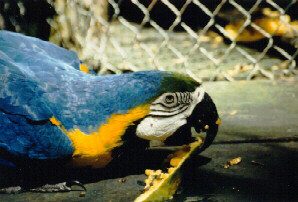 Eduard also points out a nest
belonging to large bird-eating spiders (a member of the
tarantula family) and one of our group taps on the nest
hoping to make one appear, but the spiders wisely remain
hidden inside. Our trek ends by a small stall where there
are some local people selling crafts. One of the locals
is holding a baby boa constrictor snake – only 10
centimetres long, just long enough to curl itself around
my wrist and rest in my hand. Eduard also points out a nest
belonging to large bird-eating spiders (a member of the
tarantula family) and one of our group taps on the nest
hoping to make one appear, but the spiders wisely remain
hidden inside. Our trek ends by a small stall where there
are some local people selling crafts. One of the locals
is holding a baby boa constrictor snake – only 10
centimetres long, just long enough to curl itself around
my wrist and rest in my hand.
After our forest trek, we return to Ariaú, where Susi
and I wander around, and help out with some of the
animals feeding time. The prospect of food draws birds
and monkeys from all around. It's lots of fun.
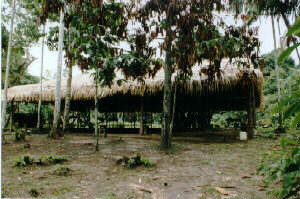 After lunch, (ours and the the
animals'), we travel off in the canoe once more to visit
a village which has recently been resettled by several
families of local Indians. These families had previously
been living in the nearby city of Manaus – but were
unhappy with its overcrowding, poverty, and lack of
control over their day-to-day lives. As such, a plot of
land close to Ariaú was made available for them,
enabling them to return to the forest and to live by
growing crops, fishing, and selling crafts. Although life
here is still difficult, and there are few material
comforts and conveniences, everyone I ask agrees that
it's "melhor que Manaus" (better than Manaus). After lunch, (ours and the the
animals'), we travel off in the canoe once more to visit
a village which has recently been resettled by several
families of local Indians. These families had previously
been living in the nearby city of Manaus – but were
unhappy with its overcrowding, poverty, and lack of
control over their day-to-day lives. As such, a plot of
land close to Ariaú was made available for them,
enabling them to return to the forest and to live by
growing crops, fishing, and selling crafts. Although life
here is still difficult, and there are few material
comforts and conveniences, everyone I ask agrees that
it's "melhor que Manaus" (better than Manaus).
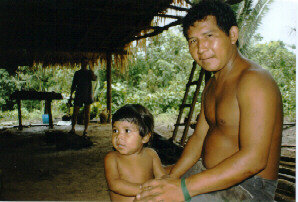 Admittedly, I'm feeling guilty
invading these people's homes – but they appear used
to the regular visitors. Eduard shows our group around
the village, explaining how its residents live, while
Susi and I wander off to chat with the locals. The main
structure is a large open-sided hut similar to those that
I've seen in photographs of Indian villages in books. The
hut provides a large covered space for cooking, social
gatherings, and a comfortable place to rest during the
day. Nearby are houses, raised off the ground similar to
the houses which we visited in the other village the
previous day. The main difference is that the walls of
these houses are made from thatched leaves instead of
timber. The village is surrounded by gardens planted with
bananas, cassava, sugar, corn and other crops. Admittedly, I'm feeling guilty
invading these people's homes – but they appear used
to the regular visitors. Eduard shows our group around
the village, explaining how its residents live, while
Susi and I wander off to chat with the locals. The main
structure is a large open-sided hut similar to those that
I've seen in photographs of Indian villages in books. The
hut provides a large covered space for cooking, social
gatherings, and a comfortable place to rest during the
day. Nearby are houses, raised off the ground similar to
the houses which we visited in the other village the
previous day. The main difference is that the walls of
these houses are made from thatched leaves instead of
timber. The village is surrounded by gardens planted with
bananas, cassava, sugar, corn and other crops.
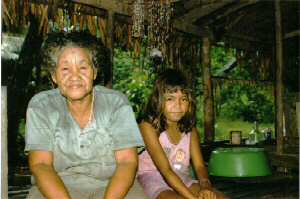 Personally, I would be nervous
living here because I've grown up in a country where I'm
reliant on modern services such as electricity,
telephones, and computers. I'm also unsure about the
quality of schooling that children receive here because
the place is so remote, and there don't seem to be any
local schools. But for the people who live here, their
village means self-sufficiency, independence, and a safe
environment to raise their families. Personally, I would be nervous
living here because I've grown up in a country where I'm
reliant on modern services such as electricity,
telephones, and computers. I'm also unsure about the
quality of schooling that children receive here because
the place is so remote, and there don't seem to be any
local schools. But for the people who live here, their
village means self-sufficiency, independence, and a safe
environment to raise their families.
Although this is an "Indian" village, life
here appears little different from life in the previous
village. With my lack of Portuguese it is difficult for
me to guess how much of the Indians' traditional culture
had been retained. My impression is that people here are
stuck between two cultures – primarily Brazilian,
but with a memories of their own rich and unique
heritage. I hope that they can retain this knowledge,
giving younger people the opportunity to learn more about
their traditional culture because it is important for a
people to know, and take pride in, where they come from.
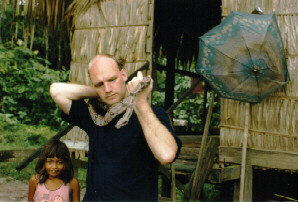 For
most people visiting the village, the highlight is the
opportunity to handle another (bigger) boa constrictor.
The snake is a pet belonging to the daughter of the
village chief, and is brought out for everyone to see.
This is the first time I've ever handled a big snake
– although I saw a few as I was travelling through
the United States, I wisely kept my distance. Handling
the boa is very different from what I'd imagined. Its
skin is smooth and warm – not at all cold and
slithery like snakes are reputed to be. For
most people visiting the village, the highlight is the
opportunity to handle another (bigger) boa constrictor.
The snake is a pet belonging to the daughter of the
village chief, and is brought out for everyone to see.
This is the first time I've ever handled a big snake
– although I saw a few as I was travelling through
the United States, I wisely kept my distance. Handling
the boa is very different from what I'd imagined. Its
skin is smooth and warm – not at all cold and
slithery like snakes are reputed to be.
That evening we set out on another expedition to
search for jacarés (alligators). And, as a result of
last night's attempt, I remember to bring a raincoat
– though, luckily, it isn't needed this time. The
night is calm and clear. There is a beautiful view of the
stars and, in the background, there is the constant hum
of crickets, frogs, birds, and water rushing past the
canoe. At one point, Eduard turns off the motor and lets
us drift in silence to enjoy the astonishing beauty of
the Amazon evening.
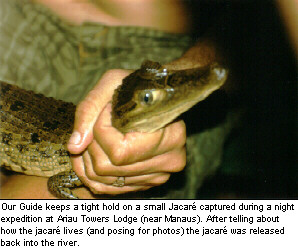 Sitting
next to me in the canoe is a beautiful and distracting
young American tourist, who is touring Brazil with her
mother. We quietly chat for a while as our canoe slides
through the dark and unlit waters – until part way
through the conversation when Susi (sitting on the other
side of me) suddenly stands on my foot. I'm not entirely
sure if this was an accident. Sitting
next to me in the canoe is a beautiful and distracting
young American tourist, who is touring Brazil with her
mother. We quietly chat for a while as our canoe slides
through the dark and unlit waters – until part way
through the conversation when Susi (sitting on the other
side of me) suddenly stands on my foot. I'm not entirely
sure if this was an accident.
Finally, after a lot of searching, we find a small
jacaré. One of the guides carefully slips into the
water, grabs it, and then hauls it up into the boat. At
this point I decide that he's insane and so say a small
prayer for his poor unfortunate family. My suspicions are
confirmed when he apologises for the jacaré being small!
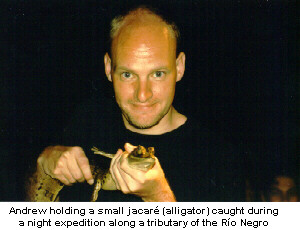 Eduard
takes hold of the jacaré, which he estimates at two
years of age, and tells us a little about how jacarés
live. The jacaré is then carefully passed around to some
of the braver passengers who pose for photographs while
the rest of the passengers gather at the back of the
canoe and cringe. Soon afterwards, the jacaré is
released back into the water, so that it can race home to
tell its friends how much it hates tourists, and plot the
revenge it will take when it becomes a big jacaré. Eduard
takes hold of the jacaré, which he estimates at two
years of age, and tells us a little about how jacarés
live. The jacaré is then carefully passed around to some
of the braver passengers who pose for photographs while
the rest of the passengers gather at the back of the
canoe and cringe. Soon afterwards, the jacaré is
released back into the water, so that it can race home to
tell its friends how much it hates tourists, and plot the
revenge it will take when it becomes a big jacaré.
Day Four: January 5
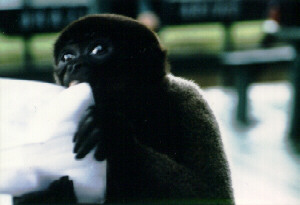 This is our last morning at
Ariaú. I'm a little sad to be leaving – although
anxious to be continuing with the rest of my journey.
After breakfast, and repacking our things, I pass the
time playing with and photographing Ariaú's monkeys
("macacas", in Portuguese). At 10am, the
speedboat which will return us to Manaus has arrived. I
lift up my backpack one more time, and store it as Susi
and I board the boat for the city. Within minutes,
everyone is aboard and the boat departs. As the boat
speeds off, I look back and watch Ariaú and the monkeys
disappearing into the distance. The silence of my
thoughts are broken a minute later when Susi starts to
speak. "Phew! You smell like your friends, the
macacas!", she teases. This is our last morning at
Ariaú. I'm a little sad to be leaving – although
anxious to be continuing with the rest of my journey.
After breakfast, and repacking our things, I pass the
time playing with and photographing Ariaú's monkeys
("macacas", in Portuguese). At 10am, the
speedboat which will return us to Manaus has arrived. I
lift up my backpack one more time, and store it as Susi
and I board the boat for the city. Within minutes,
everyone is aboard and the boat departs. As the boat
speeds off, I look back and watch Ariaú and the monkeys
disappearing into the distance. The silence of my
thoughts are broken a minute later when Susi starts to
speak. "Phew! You smell like your friends, the
macacas!", she teases.
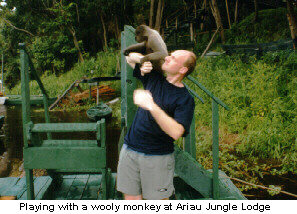

|